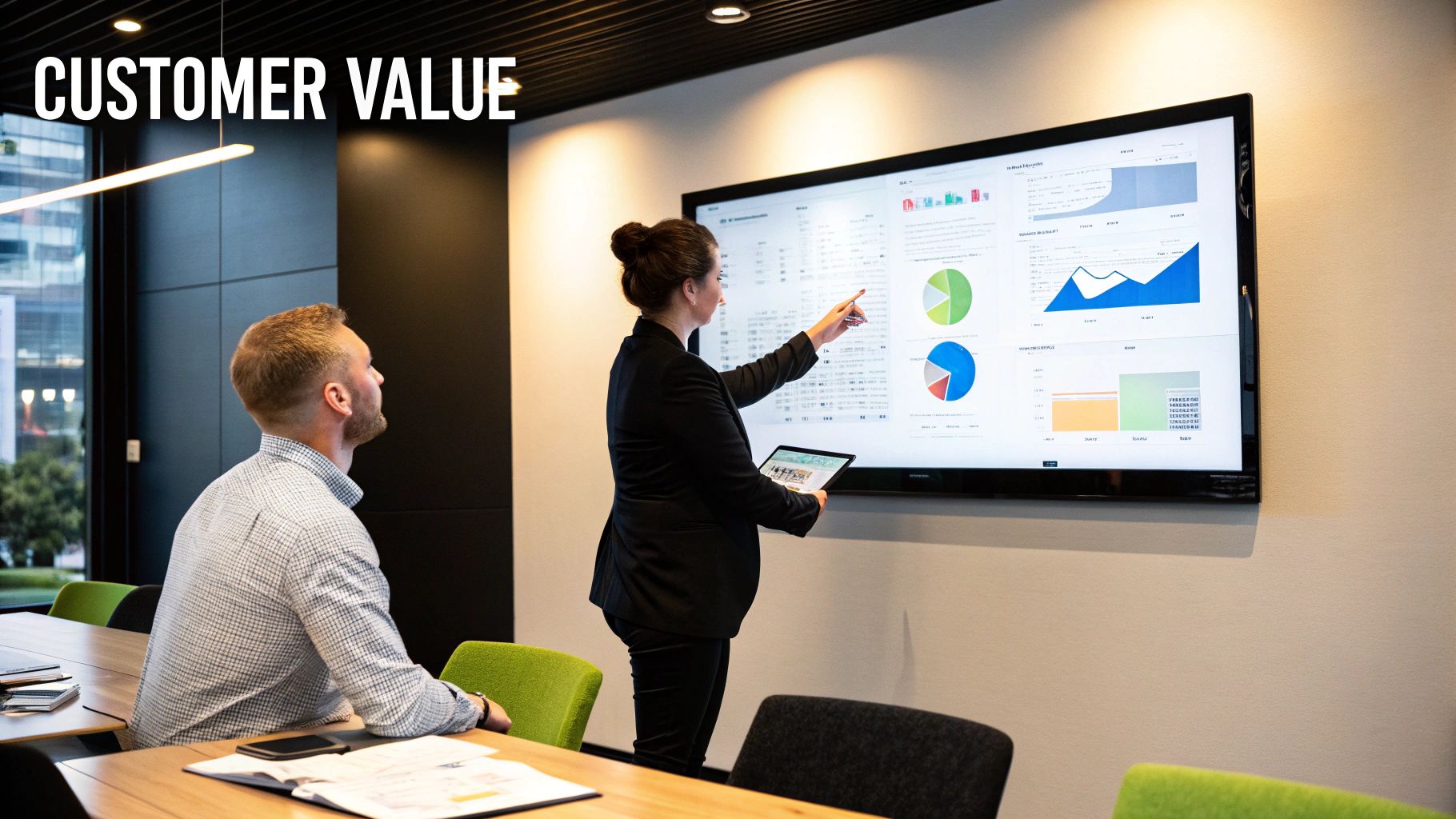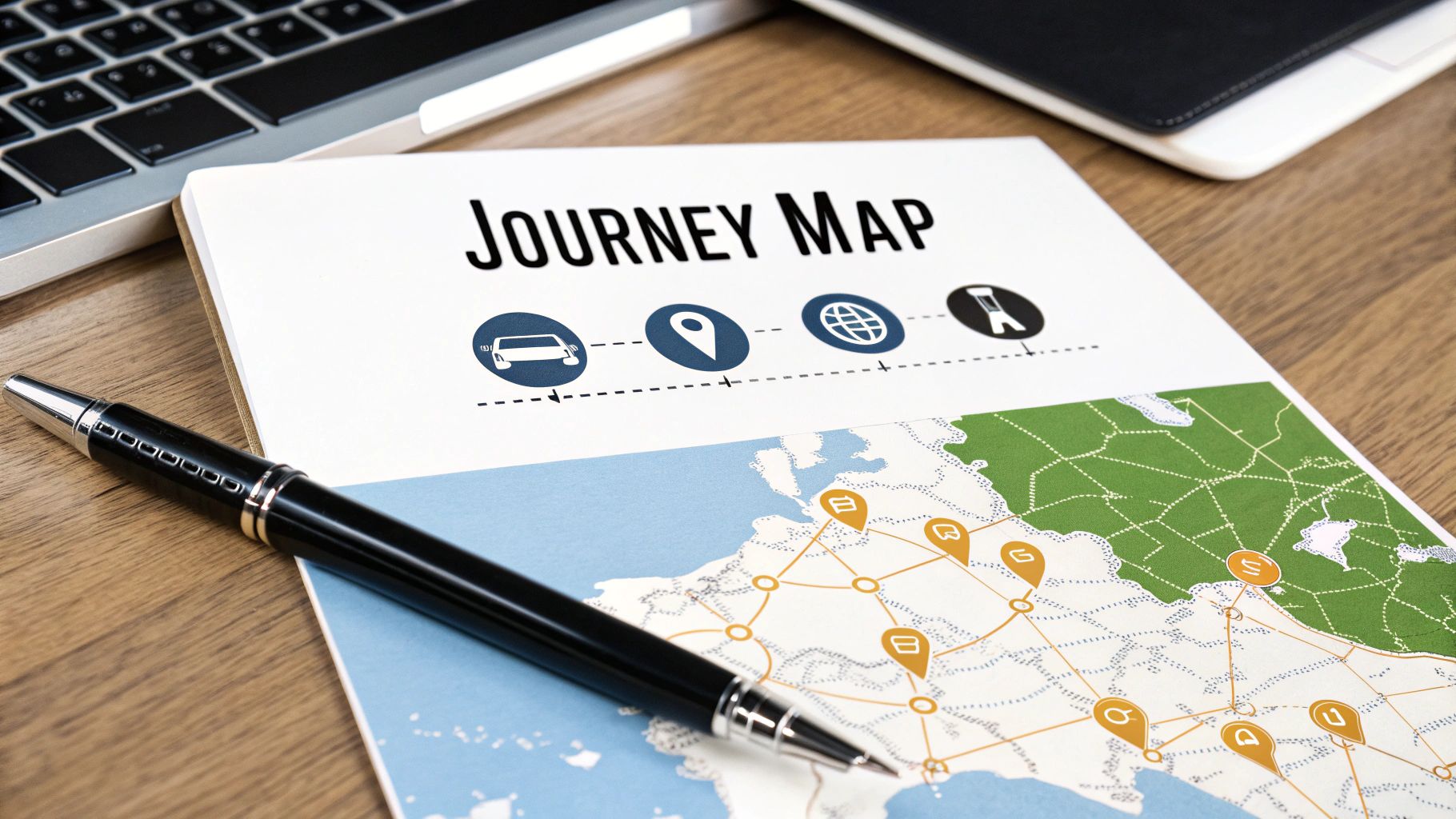In Ireland's competitive B2B market, acquiring new customers is only half the battle. Sustainable growth is built on retaining and expanding your existing customer base, but generic tactics no longer suffice. The key to unlocking long-term value lies in a sophisticated, data-driven approach that respects customer privacy under GDPR.
Many businesses focus heavily on acquisition, yet a mere 5% increase in customer retention can boost profitability by up to 95%. This article moves beyond the obvious to present nine powerful, GDPR-compliant b2b customer retention strategies tailored for the unique Irish business landscape. We'll explore actionable frameworks, from proactive health scoring and value-based success programs to account-based retention. For companies aiming to scale, mastering these techniques is not just beneficial; it's essential for market leadership.
These approaches are designed to transform your customers into loyal partners. While the tactics we'll cover are specific to complex B2B sales cycles, those in the SaaS sector might want to dive deeper into the broader landscape by exploring various customer retention strategies that apply across different business models. Let's get into the specific strategies you can implement today to secure and grow your client relationships.
1. Customer Health Score Monitoring
One of the most powerful data-driven b2b customer retention strategies involves moving from a reactive to a proactive stance with customer health score monitoring. This approach assigns a numerical value to each customer account, acting as a real-time indicator of their overall well-being and likelihood to churn or expand. By aggregating various data points, you create a holistic view that flags at-risk accounts before they disengage.

This score is calculated from behavioral metrics like product feature adoption, login frequency, and support ticket volume, combined with relationship indicators like survey feedback and engagement with your customer success team. Companies like Gainsight, a pioneer in this space, have helped clients such as Box reduce churn by up to 40% by systematically identifying and acting on health score changes. Similarly, HubSpot uses this method to maintain its impressive 95% customer retention rate.
How to Implement Customer Health Scoring
To effectively build this system, focus on a blend of quantitative and qualitative data. To accurately monitor customer health, implementing robust customer satisfaction measurement strategies is essential for gathering the qualitative feedback needed for a complete picture.
- Start Small: Begin by tracking just 3-5 key metrics. Good starting points include product usage frequency, recent support interactions, and Net Promoter Score (NPS) results.
- Automate Outreach: Set up automated workflows that trigger alerts or actions when a customer's score drops below a certain threshold. This could be an email from the Customer Success Manager or an offer for a training session.
- Review and Refine: Your scoring model isn't static. Regularly analyze your churned accounts to identify common patterns and adjust your health score criteria to improve its predictive accuracy. This ensures your model evolves with your customer base and product.
2. Value-Based Customer Success Programs
Beyond simple feature adoption, one of the most effective b2b customer retention strategies involves building a value-based customer success program. This strategic approach shifts the focus from "are they using our product?" to "are they achieving their desired business outcomes with our product?". It's about continuously demonstrating and expanding the tangible, measurable value your service delivers, directly aligning with your customer's core objectives and proving ROI.

This methodology is championed by customer success pioneers like Dan Steinman and platforms like Gainsight and Totango. It’s highly effective because it makes renewal conversations about concrete business results, not just software features. Salesforce, for example, conducts quarterly business reviews showing specific ROI metrics, helping them achieve over 90% renewal rates. Similarly, Workday creates custom value dashboards for enterprise clients to display productivity gains and cost savings, solidifying their role as an indispensable partner.
How to Implement Value-Based Customer Success
Building this program requires a deep understanding of your customer's business goals and a commitment to tracking progress against them. A key part of this involves framing the value in a way that resonates with key stakeholders, similar to the techniques found in effective lead nurturing examples.
- Establish Baseline Metrics: During onboarding, work with the customer to define and document their key performance indicators (KPIs). This creates a clear starting point from which all future value and ROI can be measured.
- Create C-Level Reports: Develop executive summary reports that translate product usage into business impact. Use metrics like cost savings, revenue generated, or risk reduction, which speak directly to C-level priorities.
- Schedule Value Reviews: Hold dedicated value review meetings, separate from tactical support calls. Use these sessions to present progress against their initial goals, showcase ROI, and strategically plan for the next period.
- Document and Share Wins: Systematically document success stories and case studies. Sharing these wins with other clients in similar segments can reinforce the value proposition and create powerful social proof.
3. Personalized Customer Journey Mapping
Effective b2b customer retention strategies require a deep understanding of the user lifecycle, and personalized customer journey mapping provides this crucial insight. This approach moves beyond generic, one-size-fits-all maps by creating detailed, individualized pathways for specific customer segments, industries, or use cases. It identifies key touchpoints, potential pain points, and critical opportunities for proactive engagement, allowing you to tailor experiences that resonate deeply and foster loyalty.

This granular level of mapping is a powerful retention tool. For instance, Adobe saw a 22% increase in renewal rates by creating personalized journeys for different creative professional segments. Similarly, Zendesk leverages this strategy to build industry-specific onboarding journeys, which has helped them improve their customers' time-to-value by an impressive 35%. The core idea, popularized by experts like Kerry Bodine, is to anticipate needs and deliver relevant value at every stage, transforming the customer experience from transactional to relational.
How to Implement Personalized Journey Mapping
Building these detailed maps requires a commitment to understanding your clients on a deeper level. To gather the necessary data, you can learn more about B2B customer research and apply those insights directly to your mapping process.
- Segment and Prioritize: Start by mapping the journey for your most valuable or at-risk customer segments. Focusing your efforts here will yield the highest initial return on investment.
- Validate with Real Data: Don't rely on assumptions. Use a mix of customer interviews, surveys, and behavioral data from your CRM or analytics platform to validate every step and touchpoint in your map.
- Align Your Teams: Ensure all customer-facing teams, from sales and marketing to support and success, understand the journey map and their specific role in delivering a seamless experience at each stage.
- Establish Feedback Loops: A journey map is a living document. Implement mechanisms to continuously gather feedback and analyze customer behavior to refine and update your maps as your product and customer base evolve.
4. Account-Based Retention (ABR)
One of the most focused b2b customer retention strategies is Account-Based Retention (ABR), an evolution of Account-Based Marketing. Instead of broad-stroke efforts, ABR concentrates your retention resources on your most valuable and strategic accounts. It involves creating hyper-personalized, coordinated engagement plans that treat each key account as a market of one, addressing their unique goals and challenges to foster deep, resilient partnerships.

This white-glove approach builds loyalty and drives expansion within your most critical customer relationships. Tech giants like IBM have used this model to achieve 95% retention among enterprise accounts by focusing on C-suite relationships. Similarly, Oracle assigns dedicated customer success architects to major accounts, while Cisco’s customer success teams leverage ABR principles with Fortune 500 clients to manage complex relationships and secure larger, more integrated contracts.
How to Implement Account-Based Retention
Effective ABR requires deep account intelligence and cross-functional alignment. Success depends on moving beyond a single point of contact to engage with the entire decision-making committee within a client's organization. This strategy is particularly powerful for B2B SaaS and service companies in Ireland managing high-value, complex accounts.
- Prioritize Strategically: Identify and tier your accounts based on revenue, growth potential, and strategic importance. Focus your initial ABR efforts on a small, manageable number of top-tier clients.
- Map Stakeholders: Create detailed maps for each priority account, identifying key decision-makers, champions, influencers, and potential detractors. Understand their individual motivations and roles in the renewal process.
- Develop Account Success Plans: For each account, build a bespoke success plan with mutually agreed-upon goals, measurable milestones, and a clear timeline. Coordinate outreach across sales, success, and marketing teams to ensure a unified message.
- Establish Executive Sponsorship: Foster relationships at the executive level. Schedule regular, high-level business reviews to discuss strategic alignment and value, reinforcing the partnership beyond day-to-day operations.
5. Proactive Support and Success Interventions
Shifting from a reactive "break-fix" model to proactive support is a cornerstone of modern B2B customer retention strategies. This approach uses data analytics and behavioral tracking to anticipate customer needs and address potential issues before they escalate. Instead of waiting for a support ticket, teams actively engage customers to ensure they are achieving their desired outcomes, thereby preventing frustration and churn.
This strategy moves beyond simple problem-solving to become a form of continuous value delivery. By identifying friction points in the user journey, you can intervene with targeted guidance, resources, or support. For instance, Intercom leveraged proactive messaging based on user behavior patterns to successfully reduce churn by 38%. Similarly, PagerDuty's customer success team intervenes with specialized support when usage data indicates a customer might be struggling with a key feature.
How to Implement Proactive Interventions
Building a proactive support system requires a deep understanding of customer goals and the right mix of technology and human touch. This often involves specific training, and successful teams frequently use targeted sales coaching techniques to equip staff with the skills to manage these sensitive, high-value conversations effectively.
- Set Up Behavioral Alerts: Configure your CRM or customer success platform to trigger alerts for concerning patterns, such as a sudden drop in product usage, neglect of key features, or repeated errors.
- Create Tiered Strategies: Not all customers require the same level of intervention. Develop a tiered approach where high-value or high-risk accounts receive personalized outreach from a Customer Success Manager, while lower-tier accounts might receive an automated email with helpful resources.
- Develop a Resource Library: Build a readily accessible library of "just-in-time" content, including tutorials, guides, and best-practice articles. This allows your team to quickly share relevant solutions when they spot a potential need, demonstrating value proactively.
6. Continuous Value Delivery and Innovation
Stagnation is a primary driver of churn in the B2B SaaS world. A powerful b2b customer retention strategy is to embed continuous value delivery and innovation into your product lifecycle. This means consistently enhancing your offering so that its value to the customer grows over time, making the decision to renew a simple one. Customers don't just pay for what your product does today; they invest in its future potential and its ability to solve their evolving challenges.
This strategy moves beyond fixing bugs and involves a proactive roadmap of feature updates, process improvements, and expanded service offerings. Amazon Web Services (AWS) exemplifies this by constantly releasing new services, which keeps clients deeply embedded in its ecosystem and expands their usage. Similarly, Microsoft’s evolution from a one-time Office purchase to the ever-improving Office 365 subscription model is a masterclass in justifying renewals through relentless innovation. This approach transforms your product from a static tool into a dynamic, growing asset for your customer.
How to Implement Continuous Value Delivery
To make this strategy a reality, you need to build a customer-centric feedback loop that directly informs your development priorities. Doing so not only improves the product but also reinforces the customer relationship, showing clients they are being heard. Investing in this type of retention can also positively impact your bottom line by lowering the need for constant new lead generation; you can explore more on reducing customer acquisition costs here.
- Create Customer Advisory Boards: Invite a select group of key customers to guide your product development. This gives you direct insight into high-value needs and makes your most important clients feel like true partners in your journey.
- Communicate the "Why": When you release new features, don't just list what they do. Clearly communicate the business value and ROI they deliver. Explain how the update helps users save time, reduce costs, or generate more revenue.
- Balance Innovation and Stability: While new features are exciting, they should not come at the cost of core stability. Ensure you have rigorous QA and beta testing programs to involve customers in the innovation process without disrupting their daily workflows.
7. Strategic Customer Education and Enablement
One of the most effective b2b customer retention strategies involves transforming one-time onboarding into a continuous learning journey. Strategic customer education focuses on empowering users to maximize the value they get from your product, turning them into expert users and internal champions. This goes far beyond initial training, creating an ecosystem of resources that helps customers solve bigger problems and achieve their strategic goals.
This proactive approach ensures customers are constantly discovering new features and best practices, which drives deeper product adoption and makes your solution indispensable to their operations. For instance, Salesforce's Trailhead platform has become a gold standard, offering gamified learning paths that not only boost user skill but also significantly improve customer loyalty. Similarly, HubSpot Academy provides free, comprehensive courses that empower users and drive a deeper, more strategic use of its platform.
How to Implement Customer Education
Building a successful education program requires a multi-faceted approach that caters to diverse learning styles and evolving needs. It's about creating accessible, engaging content that directly correlates to customer success.
- Create Tailored Learning Paths: Don't offer a one-size-fits-all curriculum. Develop distinct educational tracks for different user roles (e.g., admin vs. end-user) and experience levels. This ensures the content is always relevant to the individual's needs.
- Utilize Multiple Content Formats: Accommodate various learning preferences by offering a mix of webinars, video tutorials, in-depth articles, interactive modules, and official certification programs. This variety keeps learners engaged and makes information more accessible.
- Track Education and Retention Correlation: The ultimate goal is retention. Use your analytics to measure the link between engagement with your educational materials (e.g., courses completed, certifications earned) and key retention metrics like renewal rates and expansion revenue. This proves the ROI of your education efforts.
8. Customer Advisory Boards and Voice Programs
Establishing a formal Voice of the Customer (VoC) initiative through a Customer Advisory Board (CAB) is one of the most powerful b2b customer retention strategies for building deep, strategic partnerships. This approach moves beyond simple feedback surveys by inviting key customers to participate directly in your company's strategic planning and product development. It creates a powerful sense of ownership and co-creation, transforming your most important clients into committed brand advocates.
These programs provide an invaluable channel for unfiltered, high-level insights that you can't get anywhere else. For example, ServiceNow reports that members of its customer advisory board have a remarkable 98% retention rate, significantly higher than its already strong 85% overall rate. Similarly, enterprise giants like Microsoft and Workday use CABs to ensure their product roadmaps align perfectly with the evolving needs of their top-tier clients, directly correlating this engagement with higher renewal and expansion rates.
How to Implement a Customer Advisory Board
Building a successful CAB requires a commitment to genuine collaboration, not just a ceremonial feedback session. The goal is to give your most valuable customers a real stake in your future success, ensuring their voice has a tangible impact on business decisions.
- Select Diverse Members: Your board should be a microcosm of your ideal customer base. Invite a diverse mix of clients representing different company sizes, industries, and use cases to gain a well-rounded perspective.
- Establish Clear Expectations: Be transparent about the time commitment, roles, and responsibilities from the start. Clearly define the board's purpose and how their input will be used to ensure members feel their contribution is meaningful.
- Provide Real Influence: The key to a successful CAB is ensuring its recommendations lead to tangible action. Demonstrate how member feedback directly influences product updates, service improvements, or strategic direction to maintain engagement and trust.
- Offer Exclusive Benefits: Acknowledge the value of your members' time. Provide exclusive benefits like early access to new features, dedicated support channels, or public recognition to reward their participation and reinforce the partnership.
9. Outcome-Based Success Metrics and SLAs
Shifting from standard performance metrics to outcome-based agreements represents a profound evolution in b2b customer retention strategies. Instead of focusing on technical uptime or response times, this model ties your success directly to the tangible business results your customer achieves. This approach forges a true partnership, creating shared accountability and demonstrating your ongoing value in a language your client understands: their own bottom-line success.
This strategy moves the conversation from "Is the system working?" to "Is the system delivering the business value we need?". For instance, some CRM vendors now offer Service Level Agreements (SLAs) based on improvements in the customer's sales pipeline velocity, rather than just system availability. Similarly, IBM has long used outcome-based contracts that link their compensation to specific business results achieved by their clients, solidifying long-term, high-value relationships.
How to Implement Outcome-Based Agreements
Successfully implementing this strategy requires a deep understanding of your customer's business and a commitment to shared goals. It’s about aligning your service delivery with their core objectives. To effectively measure progress toward these shared goals, consider how you approach tracking sales performance and key metrics.
- Establish a Clear Baseline: Before the agreement begins, you must work with the customer to measure and document their current performance. This baseline is the benchmark against which all future outcomes will be judged.
- Define Controllable Outcomes: Clearly delineate which outcomes your service can directly influence versus those you cannot. This manages expectations and ensures the agreement is fair and achievable for both parties.
- Start with Pilot Programs: Identify willing, long-term customers to test outcome-based models. This allows you to refine the process, metrics, and review cadence in a lower-risk environment before rolling it out more broadly.
- Schedule Regular Outcome Reviews: Set up a recurring meeting, perhaps quarterly, to review progress against the defined business outcomes. Use this data to collaboratively identify opportunities for improvement and reinforce your value.
B2B Customer Retention Strategies Comparison
| Strategy | Implementation Complexity 🔄 | Resource Requirements ⚡ | Expected Outcomes 📊 | Ideal Use Cases 💡 | Key Advantages ⭐ |
|---|---|---|---|---|---|
| Customer Health Score Monitoring | High – requires data integration & model setup | Medium to high – data & analytics needed | Early churn warning, prioritization, upsell leads | Companies with rich customer data and CRM systems | Proactive churn prevention, objective metrics |
| Value-Based Customer Success | High – needs custom metrics & executive reports | High – requires dedicated success teams | Strong renewals, deeper relationships, premium pricing | Enterprises emphasizing ROI and business alignment | Strategic partnership, clear business value focus |
| Personalized Customer Journey | High – complex multi-segment mapping | High – marketing automation & CRM systems | Increased engagement, reduced friction | Businesses needing tailored experiences by segment | Relevant personalized touchpoints, improved satisfaction |
| Account-Based Retention (ABR) | High – multi-team coordination & account mapping | High – skilled account managers required | Max retention of top accounts, expansion revenue | Strategic accounts with high revenue potential | Deep relationships, competitive differentiation |
| Proactive Support & Interventions | Medium to high – predictive systems and outreach | Medium to high – data and outreach teams | Reduced issues, increased loyalty | SaaS and tech with predictive behavior data | Problem prevention, cost reduction |
| Continuous Value Delivery & Innovation | High – ongoing R&D and customer feedback integration | High – sustained investment in development | Sustained engagement, upsell opportunities | Technology companies focused on long-term growth | Competitive relevance, long-term partnerships |
| Strategic Customer Education | Medium to high – continuous content & program updates | Medium to high – education teams & materials | Increased adoption, reduced support | Products with complex use cases requiring training | Customer champions, reduced support |
| Customer Advisory Boards & Voice | Medium – formal structure & executive participation | Medium – coordination and management | Emotional investment, strategic feedback | Enterprise clients looking for partnership | Strong advocacy, input on strategic direction |
| Outcome-Based Success Metrics & SLAs | High – define/measure outcomes & align incentives | High – measurement & reporting infrastructure | Shared accountability, premium pricing | B2B services with measurable business impact | Vendor-customer alignment, clear value demonstration |
Building Lasting Partnerships: Your Next Steps
Moving beyond simple transactions to build genuine, lasting partnerships is the cornerstone of modern B2B success. The nine strategies we've explored, from implementing dynamic Customer Health Scores to establishing outcome-based SLAs, represent a fundamental shift in perspective. They are not isolated tactics but interconnected components of a single, powerful philosophy: true customer retention is about delivering continuous, evolving value.
The common thread weaving through each approach is a move away from reactive problem-solving towards proactive partnership. It’s about understanding your client's business so deeply that you can anticipate their needs, measure success in their terms, and consistently prove your worth. By mastering these sophisticated b2b customer retention strategies, you transform your customer relationships from a cost center into your most potent engine for predictable, sustainable growth.
Turning Insights into Action
The path to exceptional retention begins with a single, deliberate step. Avoid the temptation to implement everything at once. Instead, start by evaluating your current capabilities against the strategies outlined.
- Assess and Prioritize: Which of your high-value customer segments would benefit most from a pilot program? Perhaps launching an Account-Based Retention (ABR) initiative for your top five clients is the most logical starting point.
- Start Small and Measure: If data is a challenge, begin by formalizing your value reviews or creating your first Customer Advisory Board. These actions generate immediate qualitative insights and build momentum.
- Embrace Continuous Learning: The landscape of customer expectations is always changing. For a broader exploration of the landscape of customer retention and additional actionable advice, consider these further insights on 8 Effective Customer Retention Strategies for 2025.
The ultimate goal is to embed a culture of customer-centricity and value delivery into your organization's DNA. This means empowering your teams with the right data, tools, and mindset to see every interaction as an opportunity to strengthen the partnership. For B2B teams in Ireland, this also requires navigating the complexities of GDPR with precision, ensuring every personalized touchpoint is fully compliant.
By committing to these principles, you don't just reduce churn; you cultivate a loyal base of advocates who actively contribute to your growth through referrals, testimonials, and deeper engagement. This is how you build a resilient business that thrives not just on acquiring new logos, but on nurturing and expanding the relationships you already have. Your journey to mastering customer retention starts now.
Ready to put these strategies into practice with a GDPR-compliant framework built for the Irish market? DublinRush provides the data-driven playbooks and tools you need to monitor customer health, personalize outreach, and turn retention into your number one growth channel. Explore DublinRush today to see how we can help you build unbreakable customer partnerships.
